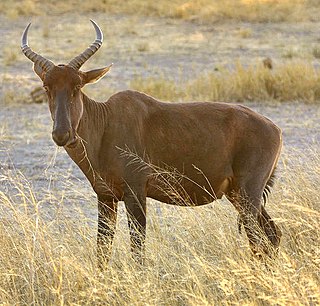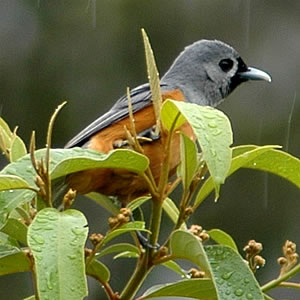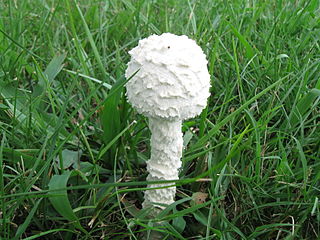Genus is a taxonomic rank used in the biological classification of living and fossil organisms as well as viruses. In the hierarchy of biological classification, genus comes above species and below family. In binomial nomenclature, the genus name forms the first part of the binomial species name for each species within the genus.

The lagomorphs are the members of the taxonomic order Lagomorpha, of which there are two living families: the Leporidae and the Ochotonidae (pikas). There are 110 recent species of lagomorph of which 109 are extant, including 10 genera of rabbits, 1 genus of hare and 1 genus of pika . The name of the order is derived from the Ancient Greek lagos + morphē.

Jasmine is a genus of shrubs and vines in the olive family of Oleaceae. It contains around 200 species native to tropical and warm temperate regions of Eurasia, Africa, and Oceania. Jasmines are widely cultivated for the characteristic fragrance of their flowers. Additionally a number of unrelated species of plants or flowers contain the word "jasmine" in their common names.

Firs are evergreen coniferous trees belonging to the genus Abies in the family Pinaceae. There are approximately 48–56 extant species, found on mountains throughout much of North and Central America, Europe, Asia, and North Africa. The genus is most closely related to Cedrus (cedar).

Coots are medium-sized water birds that are members of the rail family, Rallidae. They constitute the genus Fulica, the name being the Latin term for "coot". Coots have predominantly black plumage, and—unlike many rails—they are usually easy to see, often swimming in open water.

The cockatiel, also known as the weero/weiro or quarrion, is a medium-sized parrot that is a member of its own branch of the cockatoo family endemic to Australia. They are prized as household pets and companion parrots throughout the world and are relatively easy to breed compared to other parrots. As a caged bird, cockatiels are second in popularity only to the budgerigar.

Pauropods are small, pale, millipede-like arthropods. Around 830 species in twelve families are found worldwide, living in soil and leaf mold. They look rather like centipedes, or millipedes, and may be a sister group of the latter. However, this is controversial, as a close relationship with Symphyla has also been posited.

The bovid subfamily Reduncinae or tribe Reduncini is composed of nine species of antelope, all of which dwell in marshes, floodplains, or other well-watered areas, including the waterbucks and reedbucks. These antelopes first appear in the fossil record 7.4 million years ago in Eurasia and 6.6 Mya in Africa.

The subfamily Alcelaphinae, of the family Bovidae, contains the wildebeest, tsessebe, topi, hartebeest, blesbok and bontebok, and several other related species. Depending on the classification, there are 6–10 species placed in four genera, although Beatragus is sometimes considered a subgenus of Damaliscus, while Sigmoceros is sometimes considered for the Lichtenstein's hartebeest.

David Allan Aardsma is an American former professional baseball pitcher, currently serving in the Toronto Blue Jays front office as a coordinator of player development. He played in Major League Baseball (MLB) from 2004 to 2015 for the San Francisco Giants, Chicago Cubs, Chicago White Sox, Boston Red Sox, Seattle Mariners, New York Yankees, New York Mets, and Atlanta Braves.

Scutelleridae is a family of true bugs. They are commonly known as jewel bugs or metallic shield bugs due to their often brilliant coloration. They are also known as shield-backed bugs due to the enlargement of the thoracic scutellum into a continuous shield over the abdomen and wings. This latter characteristic distinguishes them from most other families within Heteroptera, and may lead to misidentification as a beetle rather than a bug. These insects feed on plant juices from a variety of different species, including some commercial crops. Closely related to stink bugs, they may also produce an offensive odour when disturbed. There are around 450 species worldwide.

Cronartium ribicola is a species of rust fungus in the family Cronartiaceae that causes the disease white pine blister rust. Other names include: Rouille vésiculeuse du pin blanc (French), white pine Blasenrost (German), moho ampolla del pino blanco (Spanish).

The genus Crocidura is one of nine genera of the shrew subfamily Crocidurinae. Members of the genus are commonly called white-toothed shrews or musk shrews, although both also apply to all of the species in the subfamily. With over 180 species, Crocidura contains the most species of any mammal genus. The name Crocidura means "woolly tail", because the tail of Crocidura species are covered in short hairs interspersed with longer ones.

Monarcha is a genus of bird in the family Monarchidae. They are found in Australia and Melanesia.

Myiagra is a genus of passerine birds in the family Monarchidae, the monarch flycatchers, native to Australasia, sometimes referred to as the broad-billed flycatchers or simply broadbills.

The Western Washington Vikings represent Western Washington University in intercollegiate sports in the Great Northwest Athletic Conference of the NCAA Division II with the exception of the women's rowing team which is a member of the Northwest Collegiate Rowing Conference. WWU has been an official member of NCAA Division II since September 1998. Their mascot is Victor E. Viking.
The Ankarana Special Reserve tufted-tailed rat is a species of rodent in the family Nesomyidae. It was first described in 2009. It is endemic to Madagascar, in the Ankarana Special Reserve.

Saproamanita thiersii, commonly called Thiers' lepidella, is a North-American saprotrophic basidiomycete fungus in the genus Saproamanita. It is a white mushroom originally described from Texas but today found in ten states of North America. It was named after Harry Delbert Thiers. The cap of this small mushroom is white and convex, measuring 35–100 mm (1.4–3.9 in) and covered by volval remnants. It is sticky to the touch when wet. The gills are variable in length and number and are densely packed in some specimens and widely spaced in others. They are not attached to the stipe, which is 8–20 cm (3–8 in) long and about 1 cm (0.4 in) thick, with a white ring. The spores measure 7.8–9.8 by 7.3–9.0 µm and are roughly spherical in shape. The spore print is white.
Cazuza's saki is a species of saki monkey, a type of New World monkey. It is endemic to northwestern Brazil.

















